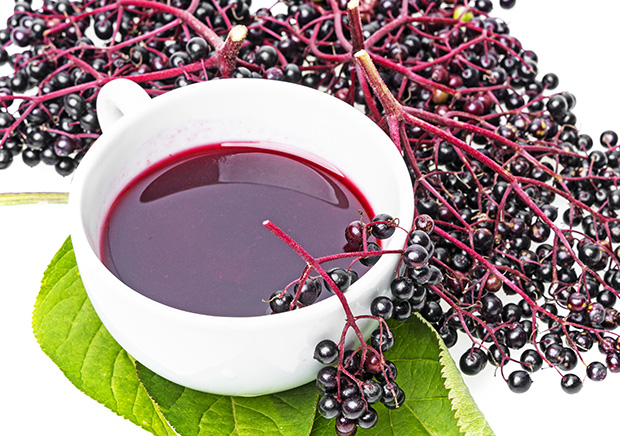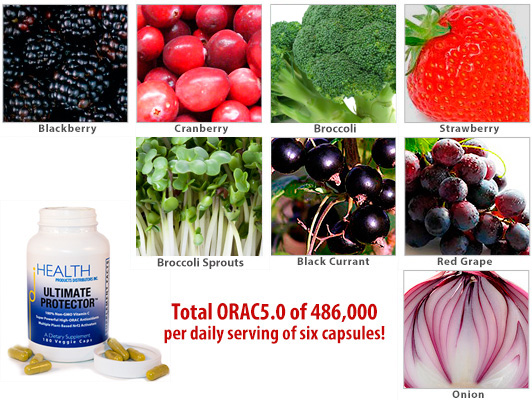 Ultimate Protector contains elderberry (Sambucus nigra), as well as components from 29 different fruits, vegetables, and herbs. Each of these ingredients contain substances that may be considered to be polyphenols, antioxidants and Nrf2 activators. In this article I will explore the ingredient elderberry which is a component of Anthocomplete® from Futureceuticals.
Ultimate Protector contains elderberry (Sambucus nigra), as well as components from 29 different fruits, vegetables, and herbs. Each of these ingredients contain substances that may be considered to be polyphenols, antioxidants and Nrf2 activators. In this article I will explore the ingredient elderberry which is a component of Anthocomplete® from Futureceuticals.
ANTHCOMPLETE™
AnthoComplete™ (N669) is a specially designed blend of anthocyanins derived from wild bilberry, wild blueberry, acai, black currant extract, sweet cherry, raspberry, elderberry, blackberry, aronia, black soybean hull extract and blue corn. Anthocyanins are powerful plant polyphenols associated with a variety of areas of human health, including healthy aging, healthy glucose metabolism, cardiovascular health and inflammation management.
Carefully designed to maximize the amount of beneficial anthocyanins that can be available in a single source, AnthoComplete is a proprietary formula suitable for a wide-range of applications.
With its diverse blend, AnthoComplete contains a minimum level of 10% anthocyanins, 3,000 ORAC μmole TE/g (typical), and 15% total phenolics (typical).
HEALTH BENEFITS OF ELDERBERRY
Elderberries were listed in the CRC Handbook of Medicinal Herbs as early as 1985, and are listed in the 2000 Mosby’s Nursing Drug reference for colds, flu, yeast infections, nasal and chest congestion, and hay fever. In Israel, Hasassah’s Oncology Lab has determined that elderberry stimulates the body’s immune system and they are treating cancer and AIDS patients with it. The wide range of medical benefits (from flu and colds to debilitating asthma, diabetes, and weight loss) is probably due to the enhancement of each individual’s immune system.

At the Bundesforschungsanstalt research center for food in Karlsruhe, Germany, scientists conducting studies on Elderberry showed that elderberry anthocyanins enhance immune function by boosting the production of cytokines. These unique proteins act as messengers in the immune system to help regulate immune response, thus helping to defend the body against disease. Further research indicated that anthocyanins found in elderberries possess appreciably more antioxidant capacity than either vitamin E or vitamin C.
Studies at Austria’s University of Graz found that elderberry extract reduces oxidation of low-density lipoprotein (LDL) cholesterol. Oxidation of LDL cholesterol is implicated in atherogenesis, thus contributing to cardiovascular disease.
The ORAC value of Elderberries is 14697 micromoles/litre of Trolox equivalents per 100 grams. This is among the highest values for fruits and berries.
Scientific Studies on the Antioxidant Effects of Elderberries and Anthocyanidins
Polyphenols pattern and correlation with antioxidant activities of berries extracts from four different populations of Sicilian Sambucus nigra L.
Abstract
Total phenolic, anthocyanin contents and antioxidant capacity of selected elderberry (Sambucuscanadensis L.) accessions.
Abstract
The effect of Sambucol, a black elderberry-based, natural product, on the production of human cytokines: I. Inflammatory cytokines.
Abstract
Characterization of anthocyanins and proanthocyanidins in some cultivars of Ribes, Aronia, and Sambucus and their antioxidant capacity.
Abstract
Inhibitory activity of a standardized elderberry liquid extract against clinically-relevant human respiratory bacterial pathogens and influenza A and B viruses.
Abstract
BACKGROUND:
Black elderberries (Sambucus nigra L.) are well known as supportive agents against common cold and influenza. It is further known that bacterial super-infection during an influenza virus (IV) infection can lead to severe pneumonia. We have analyzed a standardized elderberry extract (Rubini, BerryPharma AG) for its antimicrobial and antiviral activity using the microtitre broth micro-dilution assay against three Gram-positive bacteria and one Gram-negative bacteria responsible for infections of the upper respiratory tract, as well as cell culture experiments for two different strains of influenza virus.
METHODS:
The antimicrobial activity of the elderberry extract was determined by bacterial growth experiments in liquid cultures using the extract at concentrations of 5%, 10%, 15% and 20%. The inhibitory effects were determined by plating the bacteria on agar plates. In addition, the inhibitory potential of the extract on the propagation of human pathogenic H5N1-type influenza A virus isolated from a patient and an influenza B virus strain was investigated using MTT and focus assays.
RESULTS:
For the first time, it was shown that a standardized elderberry liquid extract possesses antimicrobial activity against both Gram-positive bacteria of Streptococcus pyogenes and group C and G Streptococci, and the Gram-negative bacterium Branhamella catarrhalis in liquid cultures. The liquid extract also displays an inhibitory effect on the propagation of human pathogenic influenza viruses.
CONCLUSION:
Rubini elderberry liquid extract is active against human pathogenic bacteria as well as influenza viruses. The activities shown suggest that additional and alternative approaches to combat infections might be provided by this natural product.
Anthocyanins protect human endothelial cells from mild hyperoxia damage through modulation of Nrf2 pathway.
Abstract
The detrimental effects of high oxygen supplementation have been widely reported. Conversely, few is known about the effects of exposure to mild hyperoxic conditions, an interesting issue since the use of oxygen-enriched mixture is now increasingly used in clinical practice and especially for professional and recreational reasons. Our study investigated if in vitro exposure of human umbilical vein endothelial cells (HUVECs) to moderate hyperoxia (O2 32 %) induces cellular alterations, measured as changes in cell signaling pathways. Furthermore, by means of an ex vivo experimental model where human volunteers were used as bioreactors, we studied whether anthocyanin metabolites are able to protect HUVECs against mild hyperoxia-induced damage. We observed that the cytotoxic effect of mild hyperoxia came along with a significant decrease in nuclear accumulation of the transcription factor Nrf2, as well as in the expression of Nrf2-regulated antioxidant and cytoprotective genes. Furthermore, under normoxic conditions, anthocyanin metabolites appeared able to activate the Nrf2 pathway, through the involvement of specific kinases (ERK1/2); this adaptive effect may explain the protective effect observed in mild hyperoxia-exposed HUVECs following anthocyanin pretreatment. This study confirms that dietary anthocyanins and/or their metabolites can protect endothelial cells against mild hyperoxia-induced alterations acting as cell signaling modulators.
A comparative evaluation of the anticancer properties of European and American elderberry fruits.
From: http://www.ncbi.nlm.nih.gov/pubmed/17201636
Abstract
European elderberry (Sambucus nigra), recognized in Europe for its health-promoting properties for many generations, is known to contain a range of anthocyanins, flavonoids, and other polyphenolics that contribute to the high antioxidant capacity of its berries. American elderberry (Sambucus canadensis), on the other hand, has not been cultivated, bred, and promoted as a medicinal plant like its better-characterized European counterpart. In this study, aqueous acetone extracts of the berries from these two species were fractionated and tested in a range of assays that gauge anticarcinogenic potential. Both cultivated S. nigra and wild S. canadensis fruits demonstrated significant chemopreventive potential through strong induction of quinone reductase and inhibition of cyclooxygenase-2, which is indicative of anti-initiation and antipromotion properties, respectively. In addition, fractions of S. canadensis extract showed inhibition of ornithine decarboxylase, an enzyme marker related to the promotion stage of carcinogenesis. Analysis of active fractions using mass spectrometry and liquid chromatography-mass spectrometry revealed, in addition to flavonoids, the presence of more lipophilic compounds such as sesquiterpenes, iridoid monoterpene glycosides, and phytosterols.
Incorporation of the elderberry anthocyanins by endothelial cells increases protection against oxidative stress.
From: http://www.ncbi.nlm.nih.gov/pubmed/10962205
Abstract
SUMMARY
Elderberry is an important fruit full of polyphenols, anthocyanins, antioxidants and Nrf2 activators that help to make Ultimate Protector such an outstanding nutritional supplement. This ingredient is becoming much more well known as research studies identify its many benefits.
ADDITIONAL RESOURCES
HPDI BLOG ARTICLES
- Questions & Answers about Ultimate Protector
- The Amazing Healing Potential of Natural Nrf2 Activators
- New Directions For Preventing Free-Radical Damage
- Natural Phytochemical Nrf2 Activators for Chemoprevention
- Ultimate Protector™ Brunswick Labs ORAC5.0™ Test Results
- Description and Comparison of ORAC Tests for Well Known Plant Ingredients and Ultimate Protector™
- Ultimate Protector™: First Impressions
- Preventing Free-Radical Damage Using Ultimate Protector™
- PRO-C™ Super Antioxidant Formula
OTHER RESOURCES
- Ultimate Protector (product page)
- ORAC Database (including food ORAC test results)


